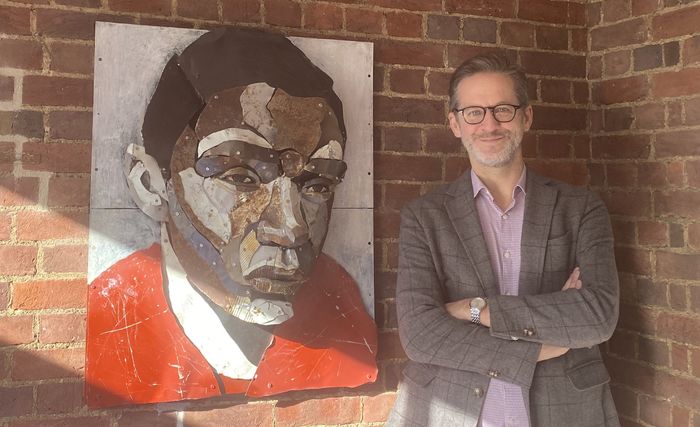‘Knick-knacks’: Miniature bear
In this first installation of her column, Eve Connor discusses Byron, Cambridge applications, and the process of making your own image, all inspired by a chance purchase of a little wooden animal

Newstead Abbey in Nottinghamshire, most famously home to the poet Lord Byron, boasts its fair share of curios. The library, installed by Thomas Wildman (Byron could only afford to renovate a few of the rooms when he took over the property in 1808), dispatches with books almost entirely on one side, cramming the shelves instead with a spiked brass dog collar, leather boxing gloves, “A Noble Poet – Scratching up his Ideas”, and a gold ring, probably betrothal, engraved with the mottoes: “Crede Byron” [trust in Byron] and “Sans peur” [without fear]. Elsewhere, a piano played by Liszt and the last known portrait of DH Lawrence. In the Grand Hall, a volunteer points out the pockmarks in the original stone wall, legacies of the poet‘s indoor pistol practice.
Then there is Byron’s bedroom. Turning up a spiral staircase that makes you one bend at the waist to eschew vertigo, I journeyed along a short corridor into green wallpaper, polished bed-steps, and a humongous yellow and silk canopy bed imported from Byron’s rooms at Trinity College. Not a lot is original – there’s a new ceiling, in fact – but an intimacy remains, especially regarding the view from the desk of the lake where Byron played at drowning until his dogs would come “rescue” him. Seclusion was the raison d’être, as he observed in a letter to his half-sister: “two people might live together without seeing, or meeting [...] Goodnight, I have to walk half a mile to my bedchamber.”
“Here’s to buying bears and braving risks”
The day before my Cambridge offer was released, I stood examining a miniature carved bear in an antique centre near Long Marston. I was in two minds. On the one hand, the bear’s blackberry eyes and little red mouth made a compelling case for his purchase, as did the symbolic significance; Byron, resisting college rules against pet dogs, had brought a tame bear with him to Cambridge. I dreamed of sneaking my own grizzly in with me. How popular I would be! What wit! As soon as the thought bloomed, doubt pruned. If I bought the bear and I didn’t get an offer, all that joy would transmute into embarrassment. I would still have to look at the thing, its ridged back and scarlet jaw lolling in mute laughter. How mortifying it would be! What hubris!
The Medieval Aberdeen Bestiary notes that bears are born formless and licked into being by their mothers. The problem is that cubs outgrow their shape, as do symbols. Critics often hail Byron as the first celebrity. A stroll through Newstead’s extensive merchandise confirms the theory. Byron as a Staffordshire figure, Byron sketched and framed in his college robes, Byron’s Cavalry helmet and its great blue-black plume, Byron’s conversations with the Countess of Blessington published in a pocket volume
Byron has ascended to the one-name hall of fame, clinking champagne flutes with the likes of Prince, Twiggy, and Zendaya, and like any effective celebrity, he divides public opinion. The 1949 film The Bad Lord Byron imagines him pleading on his deathbed before a celestial court. Mary Shelley captures the most of him in a letter to John Murray: “Our Lord Byron – the fascinating – faulty – childish – philosophical being – daring the world – docile to a private circle – impetuous and indolent – gloomy and yet more gay than any other.” Lady Caroline Lamb writes he is “mad – bad – and dangerous to know”. Most importantly, he is. Symbols, once invested, have an irritating power of endurance long after the investor wishes to forget them. Or maybe the symbol attracts a sweeter meaning, success or a Romantic manor house, and you delight in its longevity, writing Varsity articles about dead poets and teeny tiny wooden animals to keep it beating.
In the end, I bought the bear and I got my Cambridge offer. He guards the bedside table in my college room next to my phone and whatever book I’m defacing. Right now he is zipped up in my toiletry bag awaiting our Lent term return. I like what he has come to represent, a moment in my life when I wasn’t sure and pushed on regardless. It is something all of us, by virtue of being here, can recognise, and an attitude I hope to replicate going forward. Here’s to buying bears and braving risks. The packing is almost finished; through the window by my desk, I take one last look.
 News / Candidates clash over Chancellorship25 April 2025
News / Candidates clash over Chancellorship25 April 2025 News / Cambridge professor paid over $1 million for FBI intel since 199125 April 2025
News / Cambridge professor paid over $1 million for FBI intel since 199125 April 2025 Interviews / Dr Ally Louks on going viral for all the wrong reasons25 April 2025
Interviews / Dr Ally Louks on going viral for all the wrong reasons25 April 2025 Comment / Cambridge students are too opinionated 21 April 2025
Comment / Cambridge students are too opinionated 21 April 2025 News / Zero students expelled for sexual misconduct in 2024 25 April 2025
News / Zero students expelled for sexual misconduct in 2024 25 April 2025






